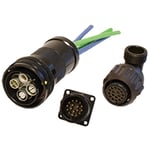When designing industrial equipment, the operating temperature of the product is often at the top of the list for design engineers. This makes sense, after all, you do not want to keep replacing failed equipment. However, while engineers give a lot of thought to heat in the equipment itself, the performance of the electrical connectors and cables that join different devices is often overlooked.
Specifying the Right Connector
For the average member of the public, choosing a connector solution is often as simple as deciding between a one or two meter USB cable. Yet, it is still frustrating when the connection starts to become unreliable.
For the engineer, the choice is more complex, and the consequences far more serious than having to wiggle the connector until it works. A dropped connection could mean losing control of heavy autonomous equipment, a stopped machine and jammed-up production line, or many other detrimental effects that are best avoided.
 While the working equipment in industrial settings is often well monitored by governing software and vigilant engineers, it is often the case that the connectors are overlooked, despite them being just as crucial as any piece of line equipment.
While the working equipment in industrial settings is often well monitored by governing software and vigilant engineers, it is often the case that the connectors are overlooked, despite them being just as crucial as any piece of line equipment.
High Temperature Application Challenges
Heat, particularly in the extreme, is a factor that engineers constantly tackle. Heat is a natural consequence of many industrial processes, and many more still involve heat directly in the process, such as smelting and other metalworks.
Most equipment uses active cooling to control this heat, such as ventilating fans, cooling lubricant sprays, and water-cooling. For the connectors this is often not possible, which makes the choice of connector in the first instance very important.
When dealing with hot environments it’s tempting to simply pick a connector with a metallic housing, such as steel or aluminum, because these metals typically don’t melt before a few hundred degrees Fahrenheit. Doing this overlooks major problems, however. For instance, the connector enclosure might easily withstand the high temperatures in question, but inside the enclosure can act as a heatsink because heat is not actively wicked away.
High Temperature Resistant Components
Many industrial connectors, such as common USB and serial ports, rely on plastic inserts to house the contacts, while other connectors may also enclose electronic components such as resistors, ballasts, and rectifying circuits, which may be susceptible to temperatures lower than the enclosure material.
Even if temperatures do not melt or scorch these plastic components, procedural stress caused by the high temperatures, as well as the effects of thermal expansion and contraction can cause connectors to fail well before their expected lifecycle.
Particular attention must be paid to connectors in hot and enclosed environments, such as on trains and boat engine rooms, where low-smoke-zero-halogen (LSZH) plastics are often used to avoid the build-up of dangerous fumes or explosive atmospheres created by burning or outgassing plastics.
 An example of this style of connector is the VEAM CIR Series from ITT Cannon, which has been specifically designed for extreme temperatures. This circular connector uses specialized LSZH plastic inserts and a variety of enclosure materials, which gives it the capability to meet ISO 834-1 fire standards, where the connectors are exposed to temperatures as high as 800°C (1,472°F).
An example of this style of connector is the VEAM CIR Series from ITT Cannon, which has been specifically designed for extreme temperatures. This circular connector uses specialized LSZH plastic inserts and a variety of enclosure materials, which gives it the capability to meet ISO 834-1 fire standards, where the connectors are exposed to temperatures as high as 800°C (1,472°F).
Low Temperature Resistant Components
Sliding back down the scale, we reach the arena of cold-temperature connectors. This initially seems far easier to solve than heat, primarily because most industrial processes are exothermic.
Therefore, the cold temperatures that electrical connectors are exposed to are often natural, with connectors being continually exposed to the elements. These cold environments often preclude the use of many plastic and rubber enclosed connectors because they can freeze and crack, creating openings for moisture to wreak havoc. Metal is also a tricky proposition, as it is often prohibitively complex to design a metal enclosure with tolerances tight enough to protect from the weather.
With the correct choice of connector configuration and materials, however, this style is perfectly possible. The Sure-Seal® connector range is one such low-temperature capable connector. Boasting IP67 and DIN 400 50 ratings, these connectors are enclosed in a PVC nitrile plastic which remains flexible, supple, and resistant to cracking down to temperatures as low as -40°C (-40°F).
PEI-Genesis: Your Partner for Extreme Temperature Connector Solutions
Many industries treat connectors as a quick, one-time decision taken during integration, despite the consequences of failure perpetually bringing the problem back onto the agenda. With some more consideration, though, possible for that decision to be truly long-lasting. At PEI-Genesis, our team recognizes the challenges involved with extreme temperature connector design. Partner with our connectivity experts to find the correct components necessary to withstand your application’s required operating temperature. 










